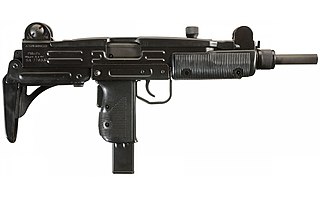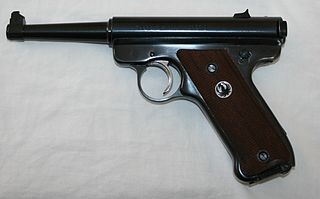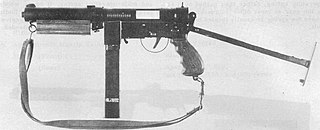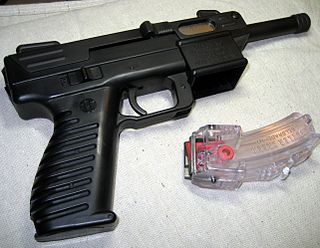
A machine pistol is an autoloading pistol capable of fully automatic fire, including stockless handgun-style submachine guns.

A submachine gun (SMG) is a magazine-fed automatic carbine designed to fire handgun cartridges. The term "submachine gun" was coined by John T. Thompson, the inventor of the Thompson submachine gun, to describe its design concept as an automatic firearm with notably less firepower than a machine gun. As a machine gun must fire rifle cartridges to be classified as such, submachine guns are not considered machine guns.

The Uzi is a family of Israeli open-bolt, blowback-operated submachine guns and machine pistols first designed by Major Uziel "Uzi" Gal in the late 1940s, shortly after the establishment of the State of Israel. It is one of the first weapons to incorporate a telescoping bolt design, which allows the magazine to be housed in the pistol grip for a shorter weapon.

The STEN is a British submachine gun chambered in 9×19mm which was used extensively by British and Commonwealth forces throughout World War II and during the Korean War. The Sten paired a simple design with a low production cost, facilitating mass production to meet the demand for submachine guns.

The Military Armament Corporation Model 10, officially abbreviated as "M10" or "M-10", and more commonly known as the MAC-10, is a compact, blowback operated machine pistol/submachine gun that was developed by Gordon Ingram in 1964. It is chambered in either .45 ACP or 9mm. A two-stage suppressor by Sionics was designed for the MAC-10, which not only abates the noise created but makes it easier to control on full automatic.

The De Lisle carbine or De Lisle Commando carbine was a British firearm used during World War II that was designed with an integrated suppressor. That, combined with its use of subsonic ammunition, made it extremely quiet in action, possibly one of the quietest firearms ever made.
The PP-19 Bizon is a 9×18mm Makarov submachine gun developed in 1993 by the Russian company Izhmash. The Bizon was designed by a team of engineers headed by Victor Kalashnikov and including Alexei Dragunov.

The Ultimax 100 is a Singapore-made 5.56mm light machine gun, developed by the Chartered Industries of Singapore by a team of engineers under the guidance of American firearms designer L. James Sullivan. The weapon is extremely accurate due to its constant-recoil operating system and is one of the lightest machine guns in the world.

The Sterling submachine gun is a British submachine gun (SMG). It was tested by the British Army in 1944–1945, but did not start to replace the Sten until 1953. A successful and reliable design, it remained standard issue in the British Army until 1994, when it began to be replaced by the L85A1, a bullpup assault rifle.
The Ruger 10/22 is a series of semi-automatic rifles produced by American firearm manufacturer Sturm, Ruger & Co., chambered for the .22 Long Rifle rimfire cartridge. It uses a patented 10-round rotary magazine, though higher capacity box magazines are also available. The standard carbine version of the Ruger 10/22 has been in production continuously since 1964, making it one of the most successful rimfire rifle designs in history, with numerous third party manufacturers making parts and accessories for upgrading and customization. The 10/22's aftermarket is so prolific that a complete 10/22 can be built without using any Ruger-made components.

The Škorpion vz. 61 is a Czechoslovak machine pistol developed in 1959 by Miroslav Rybář (1924–1970) and produced under the official designation Samopal vzor 61 by the Česká zbrojovka arms factory in Uherský Brod from 1963 to 1979. The standard version uses .32 ACP ammunition.

The Ruger Standard Model is a rimfire semi-automatic pistol introduced in 1949 as the first product manufactured by Sturm, Ruger & Co., and was the founding member of a product line of .22 Long Rifle cartridge handguns, including its later iterations: the MK II, MK III, and MK IV. It is marketed as an inexpensive .22 caliber rimfire intended for casual sport and target shooting, and plinking. Designed by company founder William B. Ruger, the Standard model and its offspring went on to become the most accepted and successful .22 caliber semi-automatic pistols ever produced.

The Welgun was a prototype submachine gun developed by the British irregular warfare organisation, the Special Operations Executive. Although it performed well in tests, it was never adopted, and was produced in small numbers only.
B&T AG is a Swiss defence supplier specializing in the design and manufacturing of firearms and tactical components such as sound suppressors and rail systems. The company is based in Thun.

The M3 is an American .45-caliber submachine gun adopted by the U.S. Army on 12 December 1942, as the United States Submachine Gun, Cal. .45, M3. The M3 was chambered for the same .45 ACP round fired by the Thompson submachine gun, but was cheaper to mass produce and lighter, at the expense of accuracy. The M3 was commonly referred to as the "Grease Gun" or simply "the Greaser," owing to its visual similarity to the mechanic's tool.

The Intratec TEC-22 is a semi-automatic handgun chambered in .22 Long Rifle. It was also marketed as the Scorpion and Sport-22. The TEC-22 operates using a straight blow-back action.
Recoil operation is an operating mechanism used to implement locked-breech autoloading firearms. Recoil operated firearms use the energy of recoil to cycle the action, as opposed to gas operation or blowback operation using the pressure of the propellant gas.
The Type 64 is a submachine gun of Chinese origin. Designed for silent operations, the Type 64 has an integral suppressor making the weapon considerably quieter. The weapon is a magazine-fed selective-fire submachine gun using a closed-bolt, blowback action, chambered for 7.62×25mm Type 51.

The Heckler & Koch VP9 is a polymer-framed semi-automatic striker-fired handgun. The VP designation in the name refers to Volkspistole, which translates to "people's pistol", while SFP stands for "striker-fired pistol". The 9 stands for the caliber designation of 9 mm. The VP9 is the third striker-fired pistol that HK has produced. A variant of the VP9, the VP40, is chambered for .40 S&W; the VP40 is known as SFP40 in Europe and Canada.
The Brügger & Thomet VP9 is a manual repeater, magazine fed, integrally-suppressed pistol created by Brügger & Thomet for use as a veterinary pistol for putting down sick and wounded animals. The design is based on the Welrod pistol.















